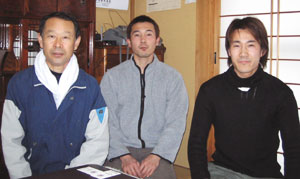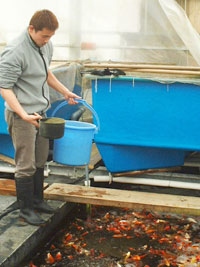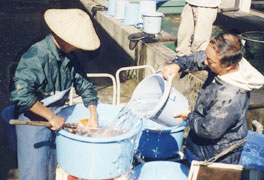
 Kawakami Koi Farm was founded by Jirosuke, my grandfather and the first generation of the farm, early in Showa (1926-1989) as a Nishikigoi wholesaler. At the time, Nishikigoi were put into food tray carriers and transported to prefectures such as Toyama and Gifu, which took one to two days. Around 1955, my father Masaru started to focus more energy on Nishikigoi distribution, while I, upon graduating from high school in 1965, began to get involved in our family Nishikigoi business. We took advantage of being closely located to Ojiya Station, stocking Koi from the whole area of Yamakoshi and shipping them out to nationwide Nishikigoi dealers upon request. We were a Nishikigoi wholesaler at the time, but later on in 1975, we started Nishikigoi production in full swing. We always have produced many varieties just like we do now. Kawakami Koi Farm was founded by Jirosuke, my grandfather and the first generation of the farm, early in Showa (1926-1989) as a Nishikigoi wholesaler. At the time, Nishikigoi were put into food tray carriers and transported to prefectures such as Toyama and Gifu, which took one to two days. Around 1955, my father Masaru started to focus more energy on Nishikigoi distribution, while I, upon graduating from high school in 1965, began to get involved in our family Nishikigoi business. We took advantage of being closely located to Ojiya Station, stocking Koi from the whole area of Yamakoshi and shipping them out to nationwide Nishikigoi dealers upon request. We were a Nishikigoi wholesaler at the time, but later on in 1975, we started Nishikigoi production in full swing. We always have produced many varieties just like we do now.
As well as producing numerous varieties of Koi as always, we had been increasing the quantity of production lately: approximately 100,000 tosai and 20,000 nisai. However, we suffered damages from the 2004 Niigata Chuetsu Earthquake such as losing our oyagoi and field ponds, so we had to decrease production. But we have now restocked oyagoi, and approximately sixty percent of the field ponds are restored; I can say that about half of our business is back to normal.
Since establishment of Kawakami Koi Farm, our everlasting goal has been to raise a “common” Nishikigoi than to raise a prize-winning Nishikigoi. I believe the basis of this comes from my grandfather. When he was a “Nishikigoi dealer,” he established credibility by treating the Nishikigoi he stocked with great care and then delivering them to nationwide dealers. We currently export 90% of our Nishikigoi, so we try to produce colorful and pretty ones. We especially put efforts in trying to produce Koi that have clear patterns from the tosai and nisai stage, in other words “young and beautiful Koi.”
I would like overseas Koi lovers to enjoy Nishikigoi in their own ways. I of course think that paying a lot of money to obtain a beautiful Nishikigoi for your pond is a way of enjoyment. But no matter how good or bad your Nishikigoi is, I as a breeder would be pleased if watching your Nishikigoi swimming in your own pond becomes a part of your daily life. |
|
||||||||||||||||||||||||||||||||||||||||||||
| (Interviewed on March 16, 2006) | |||||||||||||||||||||||||||||||||||||||||||||




